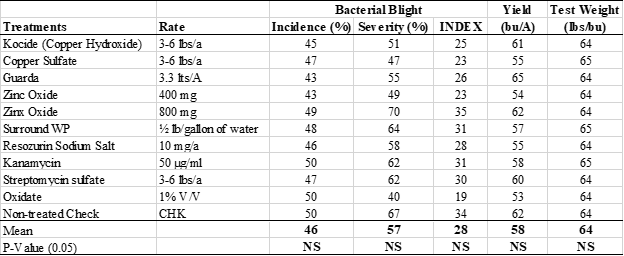A research trial was conducted at the Langdon Research Extension Center with an objective to evaluate the performance of pesticide compounds to manage bacterial blight (BB) on field pea. The trial was planted on May 18, 2022 with the field pea variety ‘Salamanca’ in a randomized complete block design replicated four times. The trial followed state recommended practices for land preparation, fertilization, seeding rate, and weed control. The plot size was 5 ft. wide x 16 ft. long with a field pea border on either side of each plot. Pesticide compounds were applied at the Vn stage (nth true leaf unfolded at nth node with tendril present) using a CO2-pressurized backpack style sprayer with a three-nozzle boom (XR-8002) at 20 GPA. Prevailing weather conditions were dry during the crop growth period so the second spray at R-stage was not applied. The amount of BB infection obtained in the research plots was based on natural infections. A rating scale of 0 – 9 was adopted from Chaudhary 1996, where the severity of BB in a plot was recorded as the percentage of tissue area infected out of total leaf area examined. Fifty leaves from each plot were sampled and measured for the average percentage of lesion area. The rating scale was 0 = 0, 1 = >1-10 %, 3 = >11-30 %, 5 = >31-50 %, 7 = >51-75 %, and 9 = >76-100 %.
A Disease Index (DI) was calculated based on severity ratings using the formula:
DI= n (1) + n (3) + n (5) + n (7) + n (9)
tn
Where: n (1), n (3), n (5), n (7) and n (9) = Number of leaves showing severity score of 1, 3, 5, 7 and 9. tn = total number of leaves scored.
Results: Favorable weather during the major part of the growth stages was congenial for bacterial blight incidence on field pea (Figure 1). There were no significant differences in the bacterial blight index (average ranged from 19 to 35%) on foliage, yield (at 13.5% moisture), and test weight (Table 1) among the pesticide compounds tested and on comparison to the non-treated check (p-value non-significant).
Figure 1: High levels of bacterial blight infections were observed on field pea plants.
Table 1: Efficacy of pesticide compounds in managing bacterial blight of field pea and their influence on yield and test weight.
